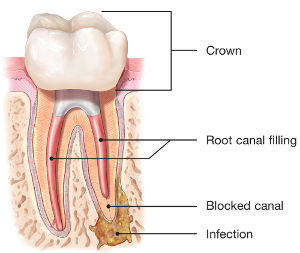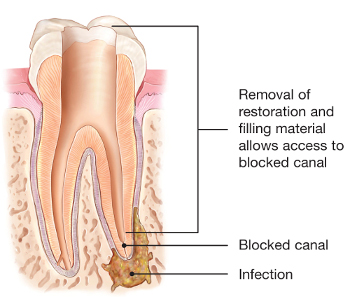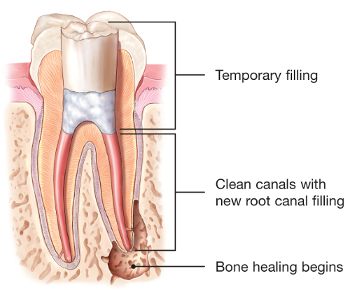Root Canal Retreatment
With proper care, even teeth that have had root canal treatment can last a lifetime. But sometimes, a tooth that has been treated doesn’t heal properly and can become painful or diseased months or even years after treatment. If your tooth failed to heal or develops new problems, you have a second chance. An additional procedure may be able to support healing and save your tooth. If you have pain or discomfort in a previously treated tooth, talk to an endodontist about retreatment.

Why do I need another endodontic procedure?
Endodontic procedures have a very high success rate. There are some cases, however, that may not heal as expected after initial treatment for a variety of reasons:

In other cases, a new problem can jeopardize a tooth that was successfully treated. For example:
Retreatment Process
In 4 steps!
First Step
Choosing RetreatmentFirst, the endodontist will discuss your treatment options.
If you and your endodontist choose retreatment, the endodontist will reopen your tooth to gain access to the root canal filling material. In many cases, complex restorative materials—crown, post and core material—must be disassembled and removed to permit access to the root canals.

Second Step
CleaningSecond, your endodontist takes a look at the damage.
After removing the canal filling, the endodontist can clean the canals and carefully examine the inside of your tooth using magnification and illumination, searching for any additional canals or unusual anatomy that requires treatment.

Third Step
Filling & SealingThird comes the temporary filling!
After cleaning the canals, the endodontist will fill and seal the canals and place a temporary filling in the tooth. If the canals are unusually narrow or blocked, your endodontist may recommend endodontic surgery. This surgery involves making an incision to allow the other end of the root to be sealed.

Fourth Step
Finish & Follow-upLastly, you'll need to set up a dental appointment
After your endodontist completes retreatment, you will need to return to your dentist as soon as possible to have a new crown or other restoration placed on the tooth to protect and restore it to its full function.

Is re-treatment right for me?
Whenever possible, it is best to save your natural tooth. Retreated teeth can function well for years, even for a lifetime.
Advances in technology are constantly changing the way root canal treatment is performed, so your endodontist may use new techniques that were not available when you had your first procedure. Your endodontist may be able to resolve your problem with retreatment.
As with any dental or medical procedure, there are no guarantees. Your endodontist will discuss your options and the chances of success before beginning retreatment.

